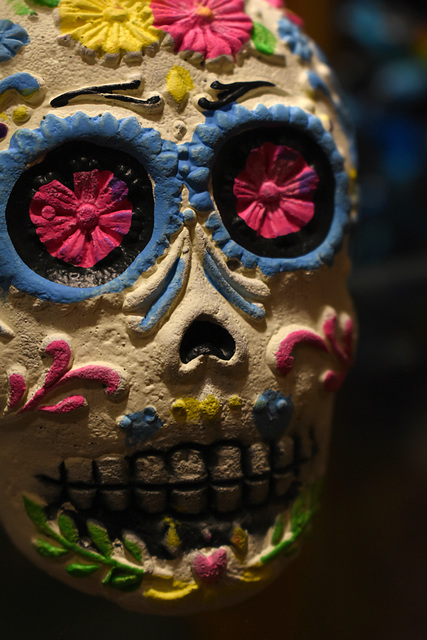Ghost Tree
Old Grapes
A Shenandoah View
Autumn Beauty
Lego Fire Brigade
Black Boot
The Falling Leaves
Through the Hourglass
"The Pleasure"
Christmas Baubles
Merry Christmas!
Catch a Shooting Star
Happy 2019!
Tiny Resolutions
Red Sparkle
Rock Ice
Frozen Garden
Icy Pareidolia
Alternate World
The Glass Abstract
One Pill A Day...
Winter Light and Shadow
A Cuppa
I got My Eye on You!
A Beary Happy Anniversary!
Autumn Green
Paper Texture
Raindrops on Beetle
Caught Between Yin and Yang
"All Paths Lead to Rome"
Amazing Infrastructure 2
Amazing Infrastructure
Rat Fink
Au Natural
Calico Rectangles and the Mirrored Cat...
Flame on a Quilt
Patchwork Squares and Rectangles
Mystery Pod
A Bisque Bather
Itsy Bitsy Spider Modified
A Garden View
Blue Glass Still Life
That's One Big Tomato!
Watching T.V.
A Close Shave...
See also...
See more...Authorizations, license
-
Visible by: Everyone -
All rights reserved
-
552 visits
Día de los Muertos


Macro Mondays 2.0: Traditions
Día de los Muertos , or "Day if the Dead" is a tradition often celebrated on 1 Nov. as a day to remember children who have passed away, and on 2 Nov. to honor adults. This holiday originated in ancient Mesoamerica (Mexico and northern Central America) where indigenous groups, including Aztec, Maya and Toltec, had specific times when they commemorated their loved ones who had passed away. The holiday is celebrated in present day Mexico and in the United States among Mexican immigrants.
Calaveritas de azucar, or sugar skulls similar to the plaster skull shown in the photo, along with toys, are left on altars for children who have passed. The skull is used not as morbid symbol but rather as a whimsical reminder of the cyclicality of life, which is why they are brightly decorated.
For a more complete description:
insider.si.edu/2016/10/5-facts-dia-de-los-muertos-day-dead
Día de los Muertos , or "Day if the Dead" is a tradition often celebrated on 1 Nov. as a day to remember children who have passed away, and on 2 Nov. to honor adults. This holiday originated in ancient Mesoamerica (Mexico and northern Central America) where indigenous groups, including Aztec, Maya and Toltec, had specific times when they commemorated their loved ones who had passed away. The holiday is celebrated in present day Mexico and in the United States among Mexican immigrants.
Calaveritas de azucar, or sugar skulls similar to the plaster skull shown in the photo, along with toys, are left on altars for children who have passed. The skull is used not as morbid symbol but rather as a whimsical reminder of the cyclicality of life, which is why they are brightly decorated.
For a more complete description:
insider.si.edu/2016/10/5-facts-dia-de-los-muertos-day-dead
autofantasia, ColRam, Fred Fouarge, .t.a.o.n. and 39 other people have particularly liked this photo
- Keyboard shortcuts:
Jump to top
RSS feed- Latest comments - Subscribe to the comment feeds of this photo
- ipernity © 2007-2025
- Help & Contact
|
Club news
|
About ipernity
|
History |
ipernity Club & Prices |
Guide of good conduct
Donate | Group guidelines | Privacy policy | Terms of use | Statutes | In memoria -
Facebook
Twitter

Nice macro too.
Excellent pour le thème
A beautiful ritual... I was already there myself.
Admired in:
www.ipernity.com/group/tolerance
HMM:)
HMM
Sign-in to write a comment.